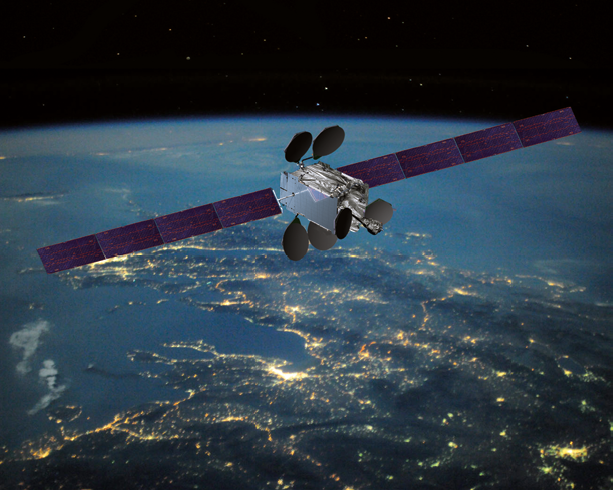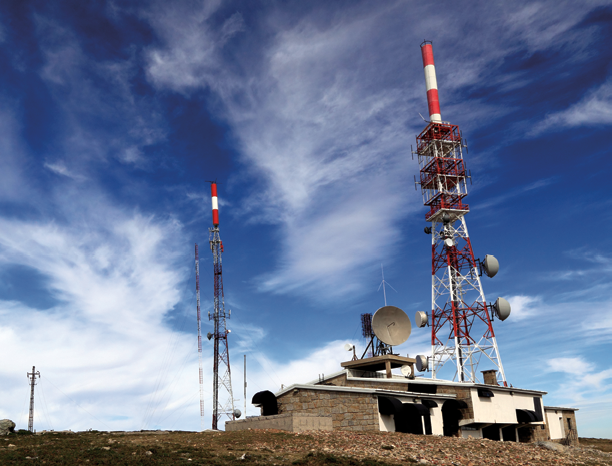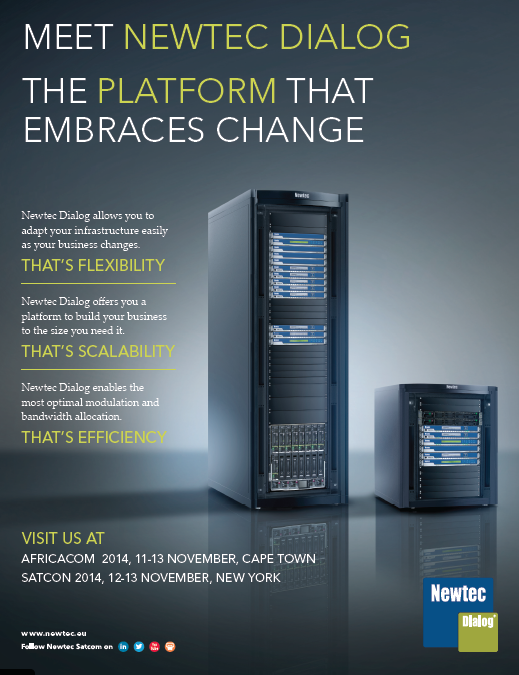The world is becoming more mobile—that’s no secret. Regions such as the Middle East and Africa (MENA), in particular, are experiencing a dramatic increase in demand for Internet-enabled mobile devices.

Artistic rendition of the Intelsat-33e satellite. Image is courtesy of Inteslat.
While global mobile data traffic will grow at a compound annual growth rate (CAGR) of 61 percent from 2013 to 2018, MENA is expected to have the strongest mobile data traffic growth of any region at 70 percent CAGR.
The need for more advanced mobile services is being driven by enterprise users, consumer broadband providers and governments. While the end user demand is evident, there are three major issues facing network providers that want to expand in these fast growing regions:
• Existing networks cannot provide the necessary quality and reliability to ensure maximum uptime for end users and are not easily scalable to address future demand in a timely manner
• Remote equipment is not powerful nor reliable enough to serve growth in rural and remote areas safely and cost-efficiently
• Difficulty in effectively managing the total cost of ownership of networks does not provide the long-term insight needed to plan future technology deployments
Addressing these complex challenges requires a strong understanding of the region, the terrain and the needs of the wireless community. Intelsat has served Africa and the Middle East since 1965, giving the company strong insight into the needs of the customers and their end users, as well as knowledge of local and regional infrastructure requirements. Intelsat’s global telecoms expertise is leveraged with the 50 satellite fleet and the terrestrial network, IntelsatOneSM, to effectively and efficiently address Africa’s increasing demand for reliable data services, particularly in the more remote areas of the region. The connectivity afforded supports economic growth, particularly for small businesses, as well as provides connectivity for medical and educational services throughout the continent.
In order to better satisfy the voracious subscriber demand, wireless operators will need a platform on which they can create differentiation and add unique value. Satellite infrastructure provides the quickest means to upgrade and expand their mobile networks—High Throughput Satellite (HTS) platforms, such as Intelsat’s EpicNG, will be able to assist network providers solve their biggest challenges as additional demand outstrips their existing networks.
Expanding Capabilities, Preparing for the Future
Using the company’s existing network, operators can expand their operations and address many of the challenges they face today in meeting end user demand. Intelsat’s satellite beams cover the entirety of Africa, which means access to the required capacity is available everywhere, not just in city centers or along the coast. What this delivers for network operators is:
• Network Expansion: The ubiquitous reach of satellite capacity can accelerate network deployment into remote and low-density regions with quick return on investment (ROI). By reducing the capital expenditures required to expand via terrestrial infrastructure, mobile network operators can focus on high-growth areas with new service propositions, including mobile broadband into remote regions.
• Reliability: Satellite technology, supported by field-proven ground equipment, provides mobile operators with a reliable means to address end-users’ communications needs. Hybrid networks consisting of fiber, microwave and satellite links ensure carrier-grade reliability and provide mobile operators the most robust network possible. Leveraging weather-resistant C- and Ku-band frequencies also ensures operators can provide the highest levels of availability with minimal operational complexity.
• Simplicity and Flexibility of Architecture: Whether it is increasing throughput to or sharing network bandwidth dynamically to adapt to changes in traffic patterns and demands, satellite-based services offers unprecedented operational flexibility for mobile network operators.

Up to the Task?
While traditional satellite capacity can provide network operators with solutions that meet today’s needs, the coming surge in the volume of data and video content will create additional congestion on network infrastructures, testing the limits of current FSS network designs.
Intelsat has responded by developing Intelsat EpicNG, a high-performance, next-generation satellite platform that delivers high-throughput technology without sacrificing user control of service elements and hardware. This technology will deliver throughput in the range of 25 to 60Gbps per satellite, and with EpicNG’s use of “best-fit” spectrum, end users will have the capability to choose the frequency band based on application needs.
The capabilities provided by Intelsat EpicNG will reduce congestion through such means as allocating bandwidth dynamically and allowing load sharing of links during times of high traffic loads. The ability to deliver capacity through traditional wide beams, as well as HTS spot beams on via the Epic fleet, will meet the emerging business demands by providing additional advantages such as smaller equipment that allows for the rollout of
solar-powered sites. The mix of capacity also provides network operators more flexibility in network design and throughput options.
Cost-Effective Capacity = Additional Opportunities
The most important design parameter for Intelsat EpicNG is lowest total cost of ownership. The backward-compatible design enables operators to leverage existing hardware, resulting in quicker, cost-effective improvements in throughput and service expansion, while the open architecture design allows for the delivery of differentiated services with flexible network topologies, service characteristics and speeds. The greater efficiency of Intelsat EpicNG will change the market dynamics and creates a larger, and more profitable addressable market for our customers, enabling new applications and solutions in every sector—broadband, cell backhaul, and mobility.

For example, the growth of small and medium enterprises (SMEs) in Africa is viewed as a critical component in driving the continent’s further economic development, job creation and increase in GDP. In order to support that growth, SMEs will need consistent broadband connectivity to help ensure that their businesses thrive in an already complex and competitive landscape.
Working with Intelsat, Vodacom offers a satellite broadband solution focused on the small office/home office (SOHO) and SME market that will provide more bandwidth at a lower total cost of ownership. By using Ku-band satellite capacity and managed services from Intelsat to enhance its Satellite Connect product line for enterprise and wholesale customers, Vodacom will demonstrate that Intelsat-enabled services can serve the professional broadband market.
The service is operating on the Intelsat 28 satellite, and once Intelsat 33e is operational, Vodacom will seamlessly access Intelsat EpicNG capacity, thanks to the network’s backward-compatibility and open architecture design. Using EpicNG, companies such as Vodacom will have a combination of wide beam and spot beam coverage that allow for seamless access to a high performance overlay that will provide additional throughput for the busiest regions of the continent.
The EpicNG platform, which includes six announced satellites as of this writing, is fully integrated with Intelsat’s existing fleet. Of the first two announced, Intelsat 33e is scheduled to launch in 2016, providing capacity for Africa, Europe, the Middle East and Asia. The two initial Intelsat EpicNG satellites will cover most populated continents and mobility routes, putting enhanced capacity where there is the greatest demand. Four additional EpicNG-class satellites are slated to launch in 2017-2019, providing further high-performance broadband coverage for Africa that will enable service providers to expand their networks across vast service territories, generate greater cost efficiencies and increase their ARPU.
Satellite and Intelsat play a vital role in the global communications infrastructure and will continue to do so in Africa. Mobile network operators will need robust solutions that provide the necessary speed and reliability for even the most remote areas.
Satellite is uniquely positioned to meet these needs due to its ability to economically provide point-to-multipoint connectivity over vast geographic areas, and Intelsat EpicNG’s combination of technology and economics will be even more compelling for our customers. Satellite solutions will ensure that network operators are able to meet the skyrocketing demand for data traffic, supporting high-quality customer experiences that will drive stronger bottom lines.

For additional information, please visit: http://www.intelsat.com/services/broadband-services-2/
About the author
Grant Marais is responsible for supporting the growth of Intelsat’s customer base in Africa, which includes leading telecommunications and wireless operators, network service providers, DTH platform operators and broadcasters. Grant has more than 15 years of experience in sales and marketing in Africa and the Middle East, including 10 years in the telecommunications industry.
About EpicNG
Intelsat EpicNG is a high performance, next-generation satellite platform that delivers global high-throughput technology without sacrificing user control of service elements and hardware.
The Intelsat EpicNG platform is a new approach to satellite and network architecture using C-, Ku- and Ka-bands, wide beams, spot beams, and frequency reuse technology to provide a host of customer-centric benefits.
Designed as a complementary overlay to Intelsat’s fixed satellite network, Intelsat EpicNG will be fully integrated with the company’s existing satellite fleet and global IntelsatOne terrestrial network.
Intelsat EpicNG is based on open architecture and engineered for backwards compatibility, allowing broadband, media, mobility and government organizations to realize the cost-efficiency of using existing hardware. Simultaneously, increased control means these organizations can build on their success by offering end-users customized, differentiated solutions—even defining such service characteristics as speed, hardware and network topology.
For Broadband
As bandwidth requirements skyrocket, the limits of current FSS network design for backhaul of 3G/4G networks are being tested around the globe. Altered multimedia mixes are creating challenging connectivity designs—this is all occurring ll while the economics of supporting equipment and customers in remote areas becomes less attractive to operators.
For broadband networks, Intelsat EpicNG enables higher data rate applications and smaller terminals. This, in turn, provides expanded market opportunities that can be served by satellite. Plus, customers have flexibility in their network solutions to use a combination of C-, Ku-, and Ka-bands to address their clients’ needs.
For cellular backhaul, Intelsat EpicNG provides the high throughputs required to support 3G/4G backhaul bandwidth requirements—dynamic bandwidth allocation for asymmetric multimedia requirements and load sharing of links during network congestion. This efficient platform overcomes lower revenue per site barriers in remote areas and enables satellite as a primary or backup solution for backbone links in populated areas.
While Intelsat’s current fleet continues to serve the large, existing installed base as well as provide primary solutions in remote areas, the Intelsat EpicNG platform can:
• Be leveraged in densely populated areas that demand more bandwidth
• Provide a low-cost solution that can push a mobile network’s edge further into rural areas
• Deliver the bandwidth needed to backup high-speed core and backbone links
• Offer economical backup to fiber and microwave links towards the edge of a network
For Mobility
There is a crying need for additional robust broadband connectivity in the maritime and aero markets. However, current satellite service offerings force customers to select between high performance and widespread coverage. With Intelsat’s global mobility platform, enhanced by Intelsat EpicNG, there is no longer a need to compromise.
Intelsat’s C- and Ku-band mobility solutions already offer mobility customers always-on broadband connectivity that rivals land-based networks. Designed as an overlay to the existing mobility fabric, the Intelsat EpicNG platform uses focused spot beams in key mobility routes to meet high-throughput and performance needs. This layered approach offers global coverage and high performance, again, opening the door for new business opportunities.
Customers can fuel their mobility applications using current wide coverage beams and the new, focused Intelsat EpicNG capacity—all without having to invest in new platform or terminal solutions.
For Media
The model for today’s satellite content delivery makes customization of channel content economically impractical. The cost of bandwidth drives the requirement for more generic platform content, while current beams are designed for wide coverage, which means all channels go to all locations.
With the Intelsat EpicNG platform, channels can be customized for a specific region and beam. Spot beams and frequency reuse provide greater throughput and drive lower cost per Mbit/s, changing the economic model for delivering localized content—by country, region, language and even culture—and increasing Average Revenue Per User (ARPU).
Working in tandem with the company’s existing fleet, Intelsat EpicNG offers the freedom to tailor content delivery solution to serve as large, or as small ,of an audience, as is desired.
Intelsat EpicNG also provides economical transmission to cable head ends, as well as point-to-point routes with scalability and cost-effective contribution links for Occasional Use (OU) video applications.
For Government
High performance, ubiquitous coverage and flexibility are critical for government and military applications. Finding the correct mix of those can often require compromises having to be made.
Intelsat EpicNG provides government and military users with 5x the bandwidth equivalent of conventional commercial satellites and two-to-three times that of WGS satellites. By leveraging a mix of wide beam, steerable spot and high-performance beams for thin/thick route traffic, Intelsat EpicNG offers outstanding performance, flexibility and security. High throughput power, combined with the existing fleet, the IntelsatOne terrestrial network, and the ability to operate all using existing terminal infrastructure results in Intelsat EpicNG requiring a hard look by those seeking government connectivity solutions.


